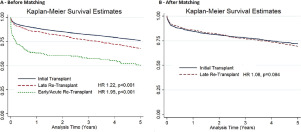The Journal of Heart and Lung Transplantation ( IF 8.9 ) Pub Date : 2019-07-08 , DOI: 10.1016/j.healun.2019.07.001 Robert J H Miller 1 , Brian A Clarke 2 , Jonathan G Howlett 2 , Kiran K Khush 2 , Jeffrey J Teuteberg 3 , Francois Haddad 3

|
BACKGROUND
Cardiac retransplantation accounts for approximately 3% of cardiac transplantation and is considered a risk factor for increased mortality. However, factors inherent to retransplantation including previous sternotomy, sensitization, and renal dysfunction may account for the increased mortality. We assessed whether retransplantation was associated with all-cause mortality after adjusting for such patient risk factors.
METHODS
We conducted a retrospective cohort study of adult and pediatric patients enrolled in the United Network for Organ Sharing database. We identified patients undergoing cardiac retransplantation based on transplant listing diagnosis and history of previous transplant. We used propensity-score matching to identify a matched cohort undergoing initial heart transplantation.
RESULTS
In total, 62,112 heart transplant recipients were identified, with a mean age 46.6 ± 19.1 years. Of these, 2,202 (3.4%) underwent late cardiac retransplantation (>1 year after initial transplant and not for acute rejection). Compared with a matched group of patients undergoing initial heart transplantation, patients undergoing late retransplantation had comparable rates of all-cause mortality at 1 year (13.6% vs 13.8%, p = 0.733). In addition, overall mortality was not significantly different after matching (unadjusted hazard ratio [HR] 1.08, p = 0.084). In contrast, patients undergoing retransplantation within 1 year of initial transplant or for acute rejection remained at increased risk of mortality post-transplant after similar matching (unadjusted HR 1.79, p < 0.001).
CONCLUSIONS
After matching for comorbidities, late retransplantation in the adult population was not associated with an increase in all-cause mortality. Our findings highlight the importance of assessing indication acuity and comorbid conditions when considering retransplant candidacy.
中文翻译:

进行心脏移植的患者的结果:UNOS注册中心的倾向匹配队列分析。
背景
心脏移植约占心脏移植的3%,被认为是死亡率增加的危险因素。但是,再移植固有的因素包括先前的胸骨切开术,致敏作用和肾功能不全可能导致死亡率增加。在调整了此类患者的危险因素后,我们评估了再移植是否与全因死亡率相关。
方法
我们对纳入器官共享网络联合网络的成年和儿科患者进行了一项回顾性队列研究。我们根据移植物清单诊断和先前的移植史确定了接受心脏再移植的患者。我们使用倾向评分匹配来识别匹配的队列,这些队列正在接受初次心脏移植。
结果
总共确定了62112名心脏移植受者,平均年龄为46.6±19.1岁。其中2,202(3.4%)人接受了晚期心脏再移植(初次移植后> 1年且未发生急性排斥反应)。与最初接受心脏移植的患者相比,接受晚期再移植的患者在1年时的全因死亡率具有可比性(13.6%vs 13.8%,p = 0.733)。此外,匹配后总体死亡率无显着差异(未调整风险比[HR] 1.08,p = 0.084)。相比之下,在初次移植后1年内接受再移植或急性排斥反应的患者,经过类似的匹配后,仍然具有更高的移植后死亡风险(HR值未调整1.79,p <0.001)。
结论
在匹配合并症之后,成年人群的晚期再移植与全因死亡率的增加无关。我们的发现凸显了在考虑再次移植候选资格时评估适应症敏锐度和合并症的重要性。



























 京公网安备 11010802027423号
京公网安备 11010802027423号